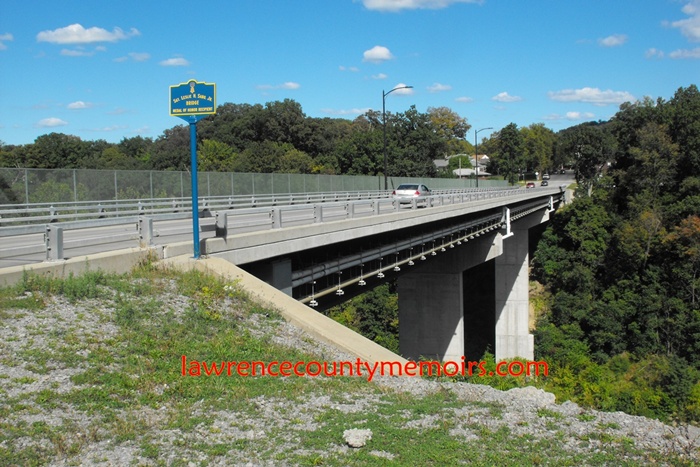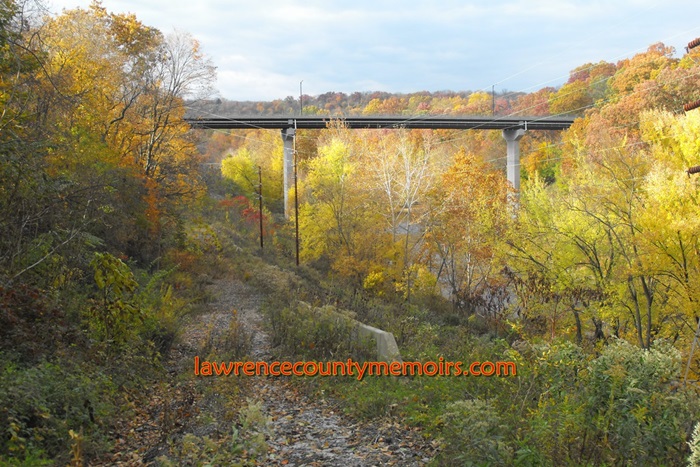In 1918 the Shelby Tube Company of the powerful U.S. Steel Company, the parent corporation of the National Tube Company (simply known as the “Tube Mill”) in Ellwood City, Pennsylvania, had decided to build a new residential area for its Tube Mill employees to help alleviate a housing shortage problem. The Shelby Land Company had been acquiring farmland in Hazel Dell across the Connoquenessing Creek from the Tube Mill, which was located along the Portersville Road (Route 488). Back in about 1909 the company had already built a popular baseball diamond in the area known as Shelby Field.
The farmland became known as the Shelby Land Company’s Plan, but was more popularly known as Wayne Park. To gain access to the area from the Tube Mill the company decided to construct a toll bridge across the steep gorge of the Connoquenessing Creek. The National Tube committed about $800,000 to build the bridge, the homes, and several small apartment buildings in addition to other improvements in include paved roads and landscaping.
Work on the piers of the “Shelby Bridge” began in about July 1918 and structural work on the span commenced later that year. Surveyors were also busy laying out the lots for the housing area, and construction on the homes began in early 1919. Despite some wintertime weather issues the bridge was completed by the summer, but was officially opened until early September 1919. The narrow bridge, which included a sidewalk for pedestrians, was free to use for all employees of the Tube Mill, but a small toll was collected from the general public.
Soon after the opening of the bridge the new homes, maybe numbering about seventy-five, were sold to employees of the company. The area was soon renamed as Ewing Park in honor of National Tube executive and attorney Thomas Ewing, who had worked diligently on the legal aspects of the new settlement. The span was became generally known as the Ewing Park Bridge, though sometimes it was referred to as the Sims Street Bridge. Ewing Park also became a borough of its own, but was annexed by Ellwood City in March 1929.
By early 1939, with the bridge in need of costly repairs, the National Tube Company began negotiations to turn the structure over to the borough council of Ellwood City. I believe the transfer was completed in June 1939 and the bridge now became public as the toll was dropped. The span, later known for its distinctive blue paint, was later closed between May-October 1940 as $30,000 in repair work was undertaken. About a decade later, in January 1949 the borough began offering to turn the bridge over to Lawrence County officials. I believe this was eventually undertaken in late 1963 when the county began performing maintenance on the superstructure of the bridge – though Ellwood City was still responsible for the pavement and walkway for some time.
The bridge, which underwent periodic repairs, remained in use for some time but finally deteriorated to the point where replacement was deemed a necessity. In 1993 a plan, involving various entities including the Pennsylvania Department of Transportation (PennDOT), called for a new bridge to be erected within a decade. Design studies began a few years later but various delays and squabbles slowed the project.
The county closed the bridge in March 2000 for an inspection and minor repair work. It was reopened two weeks later, but PennDOT immediately stepped in and closed the bridge while it conducted its own inspection. The ensuing months featured an ongoing battle of wills between the Lawrence County commissioners and PennDOT officials and also involved construction and engineering firms as well. The Ellwood City officials, mostly spectators throughout the events, even made a brief but probably foolhardy play to regain control of the bridge. The structure was briefly closed for work in July 2000, and a few additional times over the next few years, as plans were formulated to replace the span. It was finally agreed that PennDOT would pay 80% of the cost of the $8.2 million structure, while the county would pay the remainder.
On Monday, September 20, 2004, the bridge was closed to all traffic as pre-demolition efforts got underway. Just over five weeks later, on Thursday, October 28, explosive charges were detonated and “Big Blue” plummeted into the gorge below. As efforts were underway to clear away the debris it was soon determined that lead paint from the old bridge had severely contaminated the nearby soil. A two-week project, totaling $102,000, saw 817 tons of dirt removed as work on the span soon got underway. The new 585-foot-long Ewing Park Bridge, a longstanding source of strife between the county and state, was officially dedicated and opened to traffic on Friday, December 2, 2005.
In early May 2012 the Ellwood City Council launched an effort to petition the county officials to rename the Ewing Park Bridge in honor of U.S. Army Sgt. Leslie “Les” Sabo Jr., a 1966 graduate of Lincoln High School who was killed in action during the Vietnam War. That same month, after a long lost initiative was revived, Sabo was posthumously awarded the Medal of Honor for saving the lives of many of his fellow 101st Airborne soldiers during a deadly ambush in Cambodia in May 1970. The bridge-naming initiative was soon approved and on Veterans Day, November 11, 2012, a ceremony will see the bridge rechristened in Sabo’s honor.
 In 1918 the Shelby Land Company, a corporation formed in 1918, purchased a large plot of land that became known as the “Shelby Plan” (now Ewing Park) with the intention of building homes for the employees of the National Tube Mill (seen in background). To reach that property if was necessary to build a bridge, shown under construction above in 1919, across the deep chasm of the Connoquenessing Creek. Full Size |
 The bridge was built in record time and completed in July 1919, but not opened to the public until September 1919. It was a toll bridge for everyone except the employees of the National Tube Mill – many of whom occupied the various homes built by the Shelby Land Company in Ewing Park. In 1939 the borough – and later the county – assumed ownership of the bridge and the toll was lifted. (c1925) Full Size |
 The Shelby Bridge, soon known more popularly as the Ewing Park Bridge and sometimes as the Sims Street Bridge, was in use for many years until it was demolished in October 2004. The new bridge was built at the same location and opened in December 2005. (c1930) Full Size |
 The bridge was closed for a time in early October 1978 as its deck was stripped and resurfaced. This photo was taken from the south end of the bridge from Fountain Avenue/Portersville Road. (Oct 1978) Full Size |
 (Dec 2011) |  (Dec 2011) |
 The new Ewing Park Bridge is 585-feet-long and is over twice the width of the span it replaced. (Dec 2011) |  Looking southeast along the Connie Creek from the bridge. (Dec 2011) |
 (Dec 2011) Full Size |
 (Dec 2011) |  (Dec 2011) |
 An effort is underway to rename the bridge in honor of U.S. Army Sgt. Leslie “Les” Sabo Jr., a 1966 graduate of Lincoln High School who was killed in action during the Vietnam War. In May 2012, after a long lost initiative was revived, Sabo was posthumously awarded the Medal of Honor for saving the lives of many of his fellow 101st Airborne soldiers during a deadly ambush in Cambodia in May 1970. (May 2012) Full Size |
 (Oct 2012) |  (Oct 2012) |
 (Oct 2012) |  (Oct 2012) |
 (Sep 2013) Full Size |
 (Sep 2013) |  (Sep 2013) |
 (Oct 2012) |  (Oct 2012) |
 (Oct 2012) Full Size |




Comments
tom bastian #
i remember climbing underneath the old bridge girders with dave dunn just for ‘something to do’.
Comment